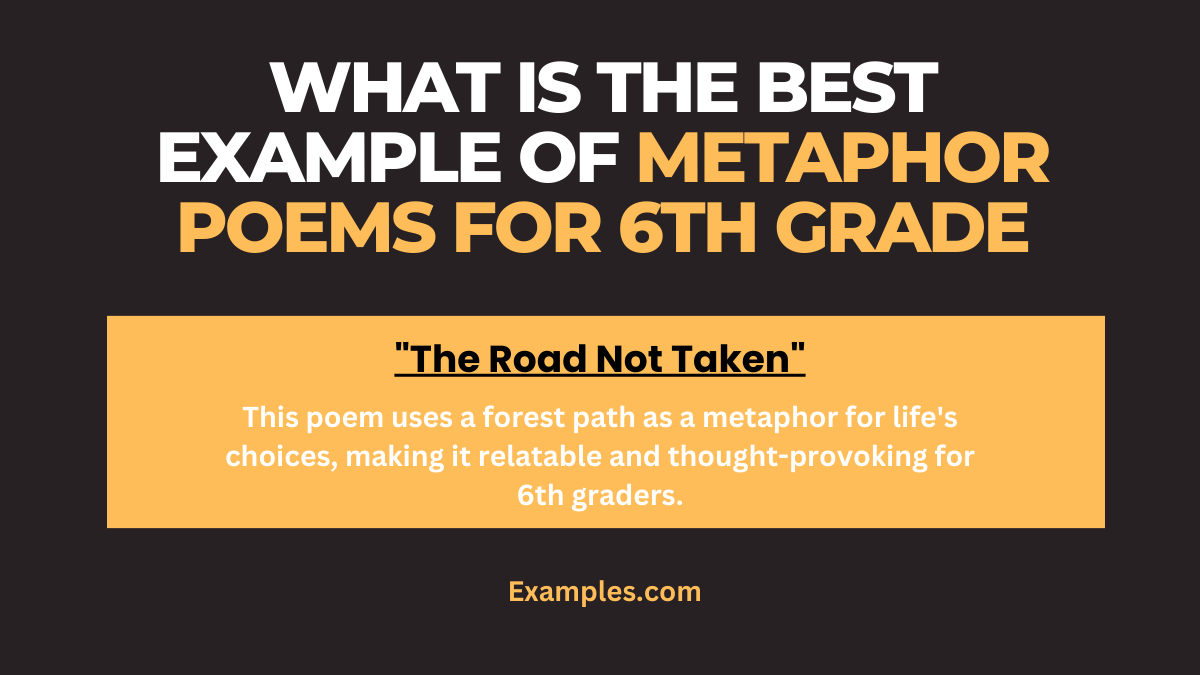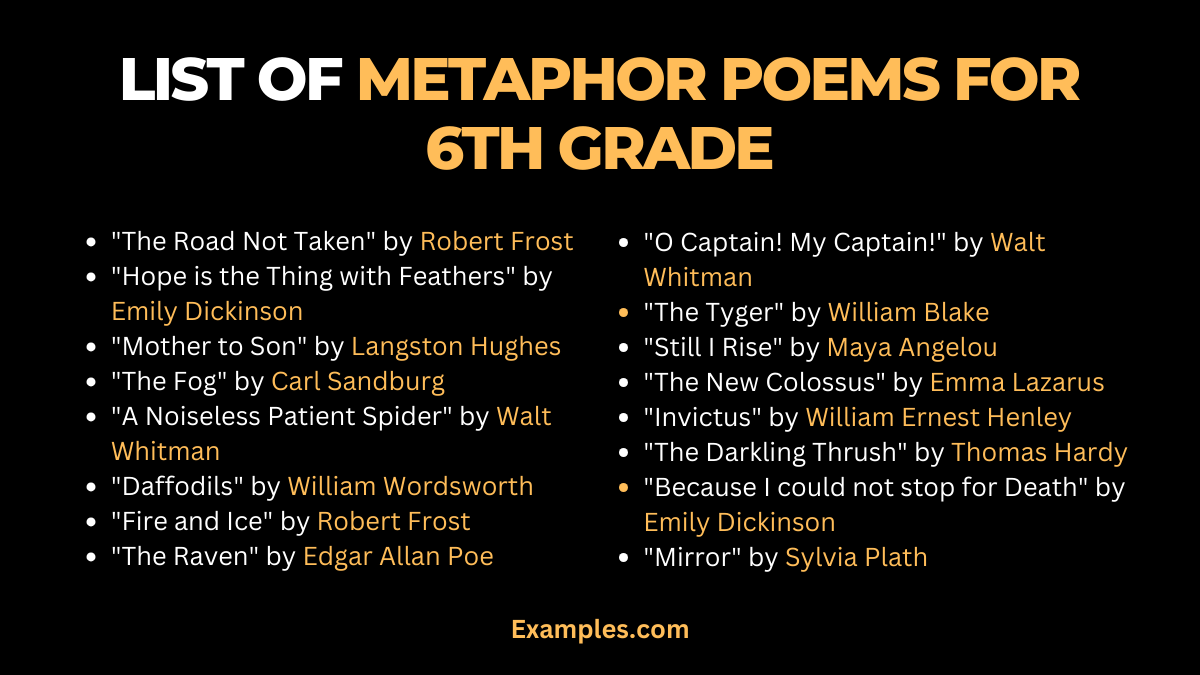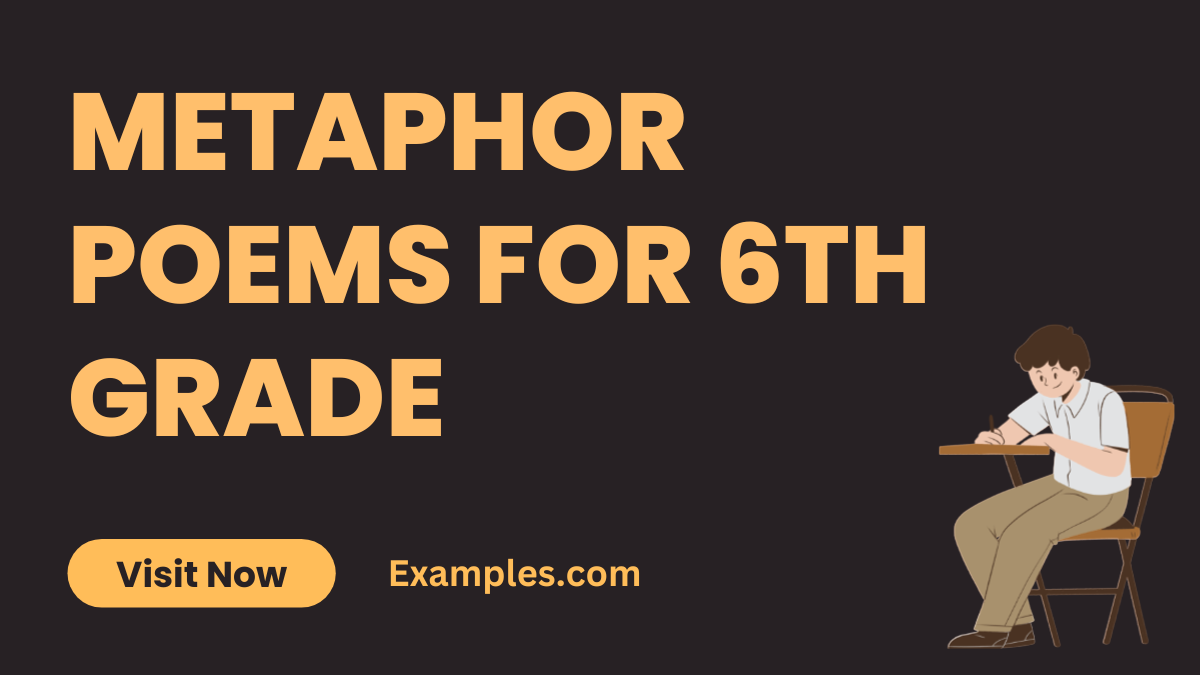14+ Metaphor Poems for 6th Grade Examples
Unlock the world of metaphors with our comprehensive guide on Metaphor Poems for 6th Grade. We delve into the essence of poetry, providing a rich assortment of metaphor examples that resonate with young minds. Our guide not only offers insightful tips but also encourages students to explore and express their creativity through words. Ideal for both classroom learning and self-exploration, these metaphor examples serve as a springboard for imaginative and meaningful poetic expressions.
Download Metaphor Poems for 6th Grade PDF
What is the Best Example of Metaphor Poems for 6th Grade?

The best example of metaphor poems for 6th graders seamlessly blends imagination with language, opening a world where words transcend their literal meanings. These poems, embodying extended metaphor examples, act as gateways to deeper understanding and creativity, offering young learners a unique perspective on how metaphors, similar to simile and metaphor examples, enrich storytelling. Ideal examples, relatable and engaging, become more than just metaphorical phrases but sources of inspiration and joy in the classroom.
List of Metaphor Poems for 6th Grade

1. “The Road Not Taken” by Robert Frost
“The Road Not Taken” is a poem by Robert Frost, a classic among metaphor poems about love and life, is often used to teach metaphors in literature/literary contexts in schools often used to teach metaphors in schools. It explores the theme of life choices and their consequences. The poem’s vivid imagery and path metaphor make it a staple in literature classes, particularly resonating with the experiences of 6th graders as they begin to make more independent decisions.
Download Full Poem The Road Not Taken PDF
Metaphors:
- “Two roads diverged in a yellow wood” – Opening Line: This metaphor symbolizes life’s choices. The ‘roads’ represent different paths or decisions, and the ‘yellow wood’ suggests that these decisions are made during a significant or changing period in life.
- “And sorry I could not travel both” – Line 2: Here, the road is a metaphor for life’s mutually exclusive choices, highlighting the impossibility of experiencing every opportunity life offers.
- “I took the one less traveled by” – Penultimate Line: This metaphor suggests choosing a less conventional or less popular path in life, symbolizing individuality and the courage to make unique choices.
2. “Hope is the Thing with Feathers” by Emily Dickinson
Emily Dickinson’s “Hope is the Thing with Feathers” is a metaphor-rich poem that personifies hope as a bird. This poem is a great tool for teaching metaphors to 6th graders as it uses simple language to convey a deep and powerful message about the nature of hope. A rich example of metaphorical poems, personifies hope as a bird. This poem, suitable for metaphor poems for 3rd grade to 6th grade, uses simple language to convey a deep message about hope, much like metaphor sentence examples.
Download Full Poem Hope is the Thing with Feathers PDF
Metaphors:
- “Hope is the thing with feathers” – Opening Line: The metaphor compares hope to a bird, suggesting that hope is uplifting and can take flight in the spirit, much like a bird in the sky.
- “That perches in the soul” – Line 2: Here, hope is metaphorically perched within the soul, suggesting a constant presence and a source of comfort.
- “And never stops at all” – Line 4: This metaphor implies the enduring and ever-present nature of hope, which, like a bird’s song, is continuous and unwavering.
3. “The Fog” by Carl Sandburg
“The Fog” by Carl Sandburg is a short, yet powerful poem that uses metaphor to describe fog. It’s particularly effective for teaching 6th graders about metaphors due to its straightforward language and clear imagery. A simple metaphor, uses metaphor to describe fog, effective for teaching 6th graders about metaphors. It’s a demonstration of how natural phenomena can be captured through metaphorical language, akin to metaphors in advertising for their vivid imagery.
Download Full Poem The Fog PDF
Metaphors:
- “The fog comes on little cat feet.” – Opening Line: This metaphor compares the fog to a cat, suggesting its silent, gentle, and stealthy approach.
- “It sits looking over harbor and city” – Line 2: The fog is personified as a sentient being, observing its surroundings, implying a quiet dominance over the landscape.
- “And then moves on” – Last Line: This metaphor portrays the fog as transient and elusive, akin to a wandering creature, emphasizing the fleeting nature of natural phenomena.
4. “Mother to Son” by Langston Hughes
“Mother to Son” by Langston Hughes is a poignant poem that uses the metaphor of a staircase to depict life’s struggles and resilience, Using the metaphor of a staircase, depicts life’s struggles and resilience, relevant for metaphor poems for 5th grade and higher. Its conversational tone and vivid metaphors make it impactful, similar to popular metaphor used in various mediums.
Download Full Poem Mother to Son PDF
Metaphors:
- “Life for me ain’t been no crystal stair” – Opening Line: This metaphor compares life to a staircase, suggesting that the mother’s journey hasn’t been easy or luxurious, much like a rough and challenging path.
- “It’s had tacks in it, And splinters” – Lines 3-4: The tacks and splinters are metaphors for the obstacles and pains encountered in life.
- “And places with no carpet on the floor—Bare.” – Lines 5-6: This metaphor suggests vulnerability and hardship, indicating parts of life where there is no comfort or ease.
5. “Daffodils” by William Wordsworth
William Wordsworth’s “Daffodils” a classic in metaphor in literature, is filled with rich imagery and metaphors. Ideal for metaphor poems for 4th grade and above, it’s an example of how nature is metaphorically represented in literature, comparable to metaphor examples in Romeo and Juliet. It’s a great example for 6th graders to understand how nature can be metaphorically represented to convey emotions and experiences. The poem speaks to the joy and beauty of the natural world.
Download Full Poem Daffodils PDF
Metaphors:
- “A host, of golden daffodils” – Line 4: The daffodils are metaphorically described as a lively crowd or gathering, emphasizing their abundance and vibrancy.
- “Fluttering and dancing in the breeze” – Line 6: This metaphor gives the flowers human characteristics, suggesting joy and liveliness.
- “They stretched in never-ending line” – Line 9: The unending line of daffodils is a metaphor for infinite beauty and the boundless wonders of nature.
6. “Mirror” by Sylvia Plath
Sylvia Plath’s “Mirror” is a profound poem that uses the metaphor of a mirror to explore themes of identity, truth, and perception. It’s an excellent piece for 6th graders, offering a deeper look into how objects can be imbued with human characteristics and emotions through metaphor. Suitable as metaphor in a song or poetry, it’s excellent for 6th graders, offering insight into how objects can be personified through implied metaphor.
Metaphors:
- “I am silver and exact. I have no preconceptions.” – Line 1: The mirror is given human qualities, metaphorically representing truth and objectivity.
- “Whatever I see, I swallow immediately” – Line 2: This metaphor suggests the mirror’s ability to absorb and reflect exactly what is before it, symbolizing honesty and directness.
- “In me, she has drowned a young girl, and in me, an old woman” – Lines 17-18: The mirror metaphorically reflects the passage of time, showing the transformation from youth to old age.
Famous Metaphor Poems for 6th Grade
1. “The Road Not Taken” by Robert Frost
This poem is a profound reflection on life’s choices and their repercussions. Originating from Frost’s own experiences, it’s widely used in educational settings to discuss decision-making and individuality.
Metaphors:
- “Two roads diverged in a yellow wood” – Opening line: Represents life’s choices.
- “And sorry I could not travel both” – Line 2: The impossibility of experiencing everything in life.
- “I took the one less traveled by” – Last stanza: The choice of an unconventional path.
2. “Hope is the thing with feathers” by Emily Dickinson
Dickinson personifies hope as a bird in this short yet powerful poem. It’s often used to teach about resilience and optimism.
Metaphors:
- “The thing with feathers” – Line 1: Hope as a bird.
- “That perches in the soul” – Line 2: Hope residing within the human spirit.
- “And sings the tune without the words” – Line 3: Hope’s persistent and enduring nature.
3. “The Raven” by Edgar Allan Poe
Known for its melancholic and dark tone, “The Raven” is a narrative poem that explores themes of loss and despair. Poe uses metaphors to enhance the poem’s haunting quality.
Metaphors:
- “The Raven” – Throughout: Symbolizes grief and unending remembrance.
- “Night’s Plutonian shore” – Line 47: Represents the realm of death and darkness.
- “And my soul from out that shadow” – Line 108: The shadow of the raven as all-consuming despair.
Simile and Metaphor Poems for 6th Grade
1. “Daffodils” by William Wordsworth
Wordsworth’s “Daffodils” is celebrated for its vivid depiction of nature. The poem is a staple in Romantic literature, using similes and metaphors to describe a field of daffodils.
Metaphors:
- “A host of golden daffodils” – Line 4: The daffodils as a joyous gathering.
- “Fluttering and dancing in the breeze” – Line 6: The daffodils’ movement likened to a dance.
- “They stretched in never-ending line” – Line 9: The vastness of nature.
2.”O Captain! My Captain!” by Walt Whitman
A poignant piece mourning Abraham Lincoln’s death, Whitman uses both metaphor and simile to convey his grief and the nation’s loss.
Metaphors:
- “O Captain! My Captain!” – Refrain: Lincoln as the captain of a ship.
- “The ship has weather’d every rack” – Line 2: The nation as a ship surviving the Civil War.
- “Fallen cold and dead” – Last line: The finality of Lincoln’s death.
Short Metaphor Poems for 6th Grade
1. “Fire and Ice” by Robert Frost
This poem is a concise yet profound exploration of emotions and the world’s end. Frost uses metaphors to discuss the themes of desire and destruction.
Metaphors:
- “Some say the world will end in fire” – Line 1: Fire as a metaphor for desire and passion.
- “Some say in ice” – Line 2: Ice as a symbol of hate and indifference.
- “I hold with those who favor fire” – Line 4: A personal inclination towards the intensity of passion.
2. “Fog” by Carl Sandburg
A brief yet impactful poem, “Fog” is known for its simplicity and imagery. Sandburg uses metaphor to describe the fog’s arrival and departure.
Metaphors:
- “The fog comes on little cat feet” – Line 1: Fog’s silent, graceful approach likened to a cat.
- “It sits looking over harbor and city” – Line 3: The fog as an observer.
- “Then moves on” – Last line: The transience of fog.
Funny Metaphor Poems for 6th Grade
“My Dog is a Soccer Fan”
This humorous poem playfully imagines a dog as an enthusiastic soccer fan. It’s widely used in classrooms to teach metaphors in a fun way, making learning enjoyable for 6th graders.
Metaphors:
- “Barks like a referee whistle” – Throughout: The dog’s bark is compared to a referee’s whistle, adding humor.
- “Runs like a winger” – Throughout: Likening the dog’s energetic running to a soccer player’s.
- “His tail, a flag of victory” – Conclusion: The dog’s wagging tail represents triumph, like a winning flag.
Metaphor Poems for 6th Grade KS2
“The Classroom as a Wildlife Safari”
This creative poem transforms a typical classroom into a thrilling wildlife safari. It’s a favorite among 6th graders for its vivid imagery and is often used to introduce metaphorical language.
Metaphors:
- “Desks like rugged terrain” – Opening lines: The desks are compared to the uneven landscape of a safari.
- “Chatter like a flock of birds” – Middle: Students’ talking likened to bird calls.
- “The clock, a slow-moving sun” – End: The classroom clock is compared to the sun moving across the sky.
In conclusion, metaphor poems for 6th grade are a brilliant blend of creativity and learning. These poems not only enliven the language arts curriculum but also foster a deeper appreciation for figurative language. From whimsical interpretations of everyday life to imaginative takes on the natural world, these popular metaphor poems captivate young minds, encouraging them to explore and enjoy the art of poetic expression.


